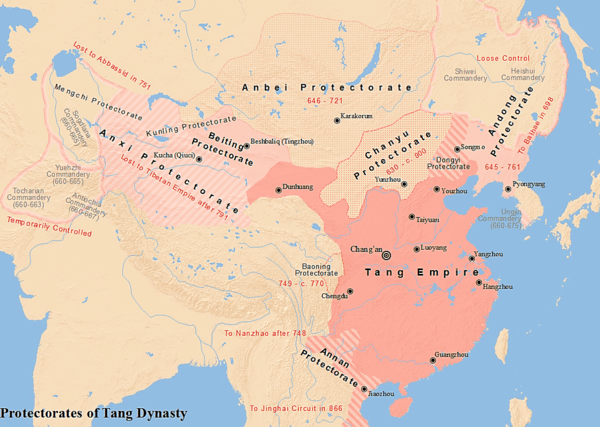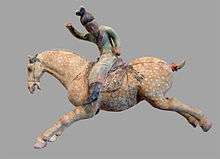Protectorate General to Pacify the East
| Protectorate General to Pacify the East | |||||||||
| Chinese name | |||||||||
|---|---|---|---|---|---|---|---|---|---|
| Traditional Chinese | 安東都護府 | ||||||||
| Simplified Chinese | 安东都护府 | ||||||||
| |||||||||
| Korean name | |||||||||
| Hangul | 안동도호부 | ||||||||
| Hanja | 安東都護府 | ||||||||
| |||||||||
The Protectorate-General to Pacify the East (simplified Chinese: 安东都护府; traditional Chinese: 安東都護府; pinyin: āndōngdūhùfǔ) was a protectorate established by the Tang dynasty in the northeast after defeating the kingdom of Goguryeo. In the place of Baekje and Goguryeo, the Tang created the Protectorate General to Pacify the East, Ungjin Commandery and Gyerim Territory Area Command.
History

After the Tang dynasty conquered Goguryeo in 668, the Protectorate General to Pacify the East, otherwise known as the Andong Protectorate, was created in Pyongyang and supposedly stationed with 200,000 soldiers. The protectorate was divided into 9 commanderies, 42 prefectures, and 100 counties.[1][2][3]
In 669 the people of Goguryeo revolted in response to Tang governance. In response the Tang forcefully deported 78,000 households and resettled them in empty areas south of the Changjiang and Huai River. The weak and poor were left behind and assigned to guard duty in service of the protectorate.[2]
From 670 to 673 the rebels launched an uprising every year, the last of which lasted for four years. The Goguryeo loyalists were aided by Silla, who were angered by Emperor Gaozong of Tang. Originally Emperor Taizong of Tang promised to exchange Baekje and the lands south of Peonyang in return for Silla's military cooperation. However Taizong died before the conquest of Goguryeo was completed, and his successor Gaozong reneged on the promise.[4]
In 675 the Tang attacked Silla and defeated them in Gyeonggi. In response Munmu of Silla dispatched a tributary mission to Tang with apologies. Gaozong accepted Munmu's apologies and withdrew Tang troops to deal with the Tibetan threat in the west. Seeing the Tang's strategic weakness, Silla renewed the advance on Tang territory.[5]
By 676 the Tang were forced to retreat and relocate the protectorate seat to the more easily defendable city of Liaoyang,[6][7][3]
In 677 the seat was moved to Xincheng, in modern Fushun, Liaoning.[6][7][3]
The deposed Bojang of Goguryeo was designated "Liaodong Commander King of Joseon" (Hangul : 요동주도독 조선왕 Hanja: 遼東州都督朝鮮王) in 667. Upon arriving in Liaodong, he plotted with the Mohe people to revive Goguryeo. News of his intentions reached the Tang, and Bojang was banished to southwestern China in 681.[8]
In 699, Go Deokmu was appointed as protectorate general of Andong, but declared independence and founded Lesser Goguryeo. In 714, the seat was moved to Pingzhou, in modern Lulong County, Qinhuangdao, Hebei.[9][8][3]
In 736, the Tang formally recognized Silla's control of Korea south of the Daedong River.[8] In 743, the seat was moved to the Old City of Liaoxi, possibly Ying Prefecture (modern Chaoyang, Liaoning.[9][8][3]
The Protectorate General to Pacify the East, otherwise known as the Andong Protectorate, was abandoned in 756 or ended in 761.[8][3]
List of protector generals
.jpg)

- Wei Zhe (668-669)
- Xue Rengui (669–670) - 안동도호부사/安東都護府使
- Gao Kan (670-676)
- Bojang of Goguryeo (677–681) - (Hangul : 요동주도독 조선왕 Hanja:遼東州都督朝鮮王) and (Hangul : 조선군왕 Hanja:朝鮮郡王)
- Qu Tuquan (681-685)
- Xue Na (685-696) 薛訥 - 安東道經略 안동도경락 - also military commander of Youjou
- Pei Xuangui (696-698) 裴玄珪
- Go Deokmu (698-699) (Hangul : 고덕무 Hanja: 高德武), Son of Bojang - 안동도독/安東都督
- Tang Xiujing (704-705) 唐休璟
- Pei Huaigu (712) 裴懷古
- Sun Jian (712) 孫儉
- Shan Sijing (713) 單思敬
- Xu Qincou (714) 許欽湊
- Xu Qindan (714) 許欽澹
- Zhang Shuo (715-719) 張說
- Xue Tai (720-725) 薛泰
- Li Jiao (727-732) 李璬
- Pei Min (733-741) 裴旻
- Jia Xun (742-755) 賈循
- Wang Xuanzhi (756-758) 王玄志
- Hou Xiyi (758-761) 侯希逸
Administrative area
Administratively, it was intended to oversee nine commanderies, 42 prefectures (later reorganized into 14) and 100 counties.
Nine commanderies
- Sinseongju (Hangul: 신성주 Hanja/Hanzi: 新城州)
- Yoseongju (Hangul: 요성주Hanja/Hanzi: 遼城州/辽城州)
- Gamulju (Hangul: 가물주 Hanja/Hanzi: 哥勿州)
- Wirakju (Hangul: 위락주Hanja/Hanzi: 衛樂州/卫乐州)
- Saraju (Hangul: 사리주 Hanja/Hanzi: 舍利州)
- Geosoju (Hangul: 거소주 Hanja/Hanzi: 去素州/居素州)
- Wueolhuiji (Hangul: 월희주 Hanja/Hanzi: 越喜州)
- Geodanju (Hangul: 거단주 Hanja/Hanzi: 去旦州)
- Geonanju (Hangul: 건안주 Hanja/Hanzi: 建安州)
14 prefectures(州)
- Namso (Hangul: 남소주 Hanja/Hanzi: 南蘇州)
- Gaemo (Hangul: 개모주 Hanja/Hanzi: 蓋牟州)
- Daena (Hangul: 대나주 Hanja/Hanzi: 大那州)
- Changam (Hangul: 창암주 Hanja/Hanzi: 倉巖州)
- Mami (Hangul: 마미주 Hanja/Hanzi: 磨米州)
- Jeokri (Hangul: 적리주 Hanja/Hanzi: 積利州)
- Yeosan (Hangul: 여산주 Hanja/Hanzi: 黎山州)
- Yeonjin (Hangul: 연진주 Hanja/Hanzi: 延津州)
- Mokjeo (Hangul: 목저주 Hanja/Hanzi: 木底州)
- Ansi (Hangul: 안시주 Hanja/Hanzi: 安市州)
- Chebok (Hangul: 제북주 Hanja/Hanzi: 諸北州)
- Shikri (Hangul: 식리주 Hanja/Hanzi: 識利州)
- Buryeol (Hangul: 불열주 Hanja/Hanzi: 拂涅州)
- Baehan (Hangul: 배한주 Hanja/Hanzi: 拜漢州)
References
- ↑ "舊唐書". 中國哲學書電子化計劃. Retrieved 3 August 2017.
安東都護府總章元年九月,司空李勣平高麗。高麗本五部,一百七十六城,戶六十九萬七千。其年十二月,分高麗地為九都督府,四十二州,一百縣,置安東都護府於平壤城以統之。In the ninth month of the first year of the Zongzhang era [668], the Minister of Works Li Ji pacified Goguryeo. Originally Goguryeo had 5 regions, 176 cities, and 697,000 households. In the twelfth month of that year, Goguryeo’s territory was divided into 9 commanderies, 42 prefectures, and 100 counties. The Andong Protectorate was situated at Peongyang to govern it.
- 1 2 Wang 2013, p. 81.
- 1 2 3 4 5 6 Xiong 2008, p. 43.
- ↑ Wang 2013, p. 82.
- ↑ Wang 2013, p. 83-84.
- 1 2 "舊唐書". 中國哲學書電子化計劃. Retrieved 3 August 2017.
上元三年二月,移安東府於遼東郡故城置。儀鳳二年,又移置於新城。In the second month of the third year of the Shangyuan era [676], the seat of Andong was moved to the Old City of Liaodong. In the second year of the Yifeng era [677], it was move again, this time to Xincheng.
- 1 2 Wang 2013, p. 84.
- 1 2 3 4 5 Wang 2013, p. 85.
- 1 2 "舊唐書". 中國哲學書電子化計劃. Retrieved 3 August 2017.
開元二年,移安東都護於平州置。天寶二年,移於遼西故郡城置。In the second year of the Kaiyuan era [714], the Andong Protectorate was moved to Ping Prefecture. In the second year of the Tianbao era [743], it was moved to the old commandery seat of Liaoxi.
Bibliography
- Lee, K.-b. (1984). A new history of Korea. Tr. by E.W. Wagner & E.J. Schulz, based on the Korean rev. ed. of 1979. Seoul: Ilchogak. ISBN 89-337-0204-0
- Wang, Zhenping (2013), Tang China in Multi-Polar Asia: A History of Diplomacy and War, University of Hawaii Press
- Xiong, Victor (2008), Historical Dictionary of Medieval China, United States of America: Scarecrow Press, Inc., ISBN 0810860538
